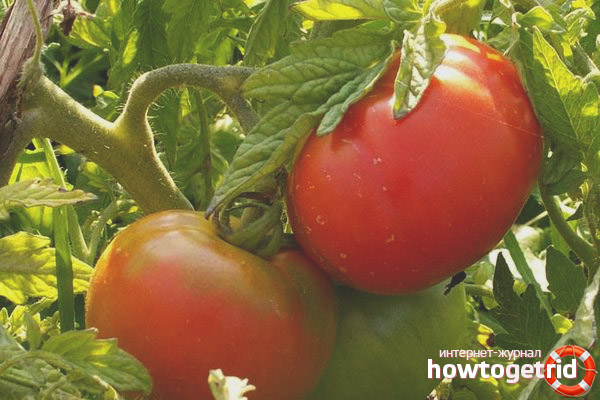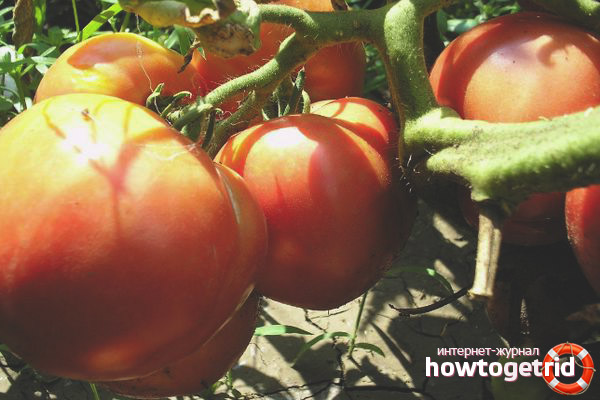The content of the article
Some crops have varieties and hybrids that are suitable for relatively inexperienced gardeners. Tomato Earthly love - one of these varieties. Bred by Russian breeder Pancev Yuri Ivanovich. It is registered in the state registry and officially approved for cultivation since 2010.
Plant characteristics and yield
Plants of this variety are determined by the nature of growth. They grow to a height of 1.20-1.30 m in the open, 1.5 m in greenhouses and need to be formed and tied up. They can be grown both in greenhouses and in open ground. The first fruits ripen 90-105 days after seed germination, so the variety is considered early.
The fruits grow relatively large - up to 200-230, less often 300 g. In shape they are round and even without ribs and greens at the base. The skin is dense and resistant to cracking. The color of the fruit is richly red or burgundy. The pulp is sweetish in taste and contains many vitamins.
Fruits have good shelf life and transportability, while they have an attractive presentation, in particular, the yield of marketable products is 95%. By purpose, the fruits are universal, that is, they are tasty both fresh and canned.
Grade advantages:
- early ripening;
- high immunity to diseases;
- good taste;
- does not need to be stepson in open ground.
Disadvantages:
- low stalk strength;
- fragility of stems;
- increased dependence on top dressing.
Growing recommendations
Sowing dates should be determined taking into account the landing site and climate in the area where your site is located. Growing most often begins with the preparation of seeds for sowing. Seeds of own production are usually recommended to sort and disinfect. They should be sown with a seeding to a depth of 1-2 cm. After this, the container with seeds should be closed with a film and taken to a place where the temperature will be about 25 degrees. If possible, in March it is useful to illuminate with fluorescent lamps or special phytolamps so that the total daylight hours would be about 14-16 hours. Incandescent lamps cannot be used.
In phase 2 of these leaves, it is usually recommended that the seedlings are planted in cassettes or glasses. The need for seedlings for top dressing depends on the selected soil and partly on the room temperature. From fertilizers, extracts from biohumus, fertilizers of the EM series, Fertika are suitable. Before landing, hardening at a temperature of 14 degrees is recommended.
Before landing, it is recommended to make in terms of 1 square. m in a bucket of compost, 1 glass of ash and 25 g of superphosphate. For 1 square. m can be planted up to 4-5 plants.
Care
The formation of plants in 2-3 stems is recommended, in addition, the removal of stepsons with an interval of 10-12 days. It is recommended to feed during periods of flowering, setting and ripening. For feeding, infusion of mullein, diluted 5 times, extracts from vermicompost, such as Gumidar, Gumistar, etc., as well as mineral fertilizers Rastrin, Zdrazen and others are suitable.
Plant protection
From diseases
Tomato plants, including Earthly Love, can be affected by many diseases, including late blight, fusariosis, verticillosis, and macrosporiosis.
- For prevention, it is permissible to use both chemical and biological fungicides. From biofungicides it is worth using Alirin-B, Trichoderma viride, Bactofit. Of the chemicals allowed: Abiga Peak, 1% Bordeaux mixture, Ordan, Profit.
- Tomatoes can also be affected by bacterial spotting. To protect against it, Fitolavin and Gamair are suitable. The latter is practically non-toxic.
- Among the diseases there are both infectious and physiological ones, for example, apical rot. This disease has 2 varieties: infectious and non-infectious. If there is no smell, then the form is physiological. In this case, top dressing with a 0.2% solution of calcium nitrate is needed.
From pests
Tomatoes can be damaged by the Colorado potato beetle, slugs, whiteflies, scoop caterpillars, wireworms. In some regions, thrips and aphids are possible.
To combat the Colorado potato beetles and their larvae, you can use Fitoverm, Bitoksibacillin, Fastak. To protect plants from slugs, you need a complex of mechanical and chemical methods, in particular, the installation of traps, sprinkling earth with lime or ground superphosphate. For protection against whiteflies, spraying with such preparations as Intavir, Spark is recommended. To combat wireworms, there are both chemical and biological preparations. Of the first, Provotox can be called, and of the second, Nemabakt and Anthem-F.
Video: 10 mistakes when growing tomatoes











Submit